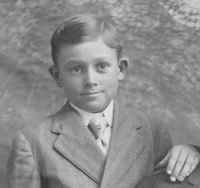 middle of 3 surviving sons of Andrew Jackson Wheeler and May Belle
Osborn-Wheeler. In 1902 the Wheeler
family moved from Newville to the newer town of
middle of 3 surviving sons of Andrew Jackson Wheeler and May Belle
Osborn-Wheeler. In 1902 the Wheeler
family moved from Newville to the newer town of Harry St Clare Wheeler,
His Navy Years - World War I, 1917-1919;
A quest to learn more about my father
By O. Keith Wheeler, August 2007
Harry St Clare was born on  middle of 3 surviving sons of Andrew Jackson Wheeler and May Belle
Osborn-Wheeler. In 1902 the Wheeler
family moved from Newville to the newer town of
middle of 3 surviving sons of Andrew Jackson Wheeler and May Belle
Osborn-Wheeler. In 1902 the Wheeler
family moved from Newville to the newer town of
Brother Gus foreground - Young St Clare - next to youngest in center of Corning family photo, ca. 1905. [click photo for details] |
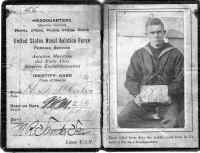 assignment to the United States Naval Aviation Force,
Foreign Service, with “Duty: Aviation,
assignment to the United States Naval Aviation Force,
Foreign Service, with “Duty: Aviation,
|
Curtiss HS single-engined patrol flying boat built for the US Navy during World War I (image from Navy recruiting poster) |
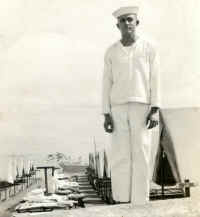
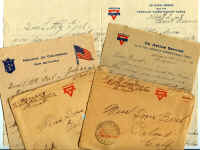 "Somewhere in
"Somewhere in
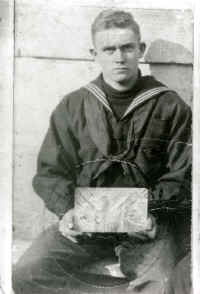 St
Clare’s WWI letters are not great works of literature.
They are a teenager’s personal expressions to his “sweetheart” who
was then a high school student back in the States.
In his earlier letters he gives little information about conditions or
his activities. For example, here is
an excerpt from his undated letter from “Somewhere in
St
Clare’s WWI letters are not great works of literature.
They are a teenager’s personal expressions to his “sweetheart” who
was then a high school student back in the States.
In his earlier letters he gives little information about conditions or
his activities. For example, here is
an excerpt from his undated letter from “Somewhere in
We
have had quite a lot of snow over here and it has frozen hard as ice.
We have good times over here but I would sooner be in the States.
… I haven't much to say only everything is O.K. over here.
I can't put in much about any thing over here or they would throw out the
letters.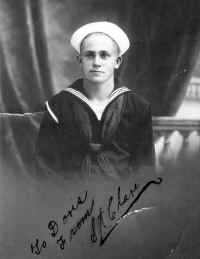
So it would seem military
censorship, or the fear thereof, limited information given.
This is again implied by comments in his
I
can't write much for there's nothing to write about.
I had my picture taken the other day.
You will find one in this envelope.
A month later he writes on
“Knights of Columbus” stationary with a return address of “Base Hospital
No. 5,” relating that he has been recovering from an appendix operation.
He then briefly adds:
…
they are sure hitting the Germans pretty hard now and it won't be long before
the war will end.
As the war winds down,
his descriptions expand:
I guess I will go out
on liberty this afternoon to a beach where the Y.M.C.A. has a hotel and come
back Sunday night.
There is some fine scenery out in the country.
When you go on these small trips you see lots of interesting things.
I wish you could see some of the scenery I've seen since I've been over
here. This coming November will be a
year out of old
|
2 copies of same photo found |
Name of ship in background? |
|
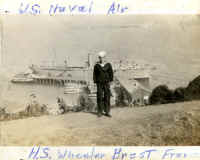 |
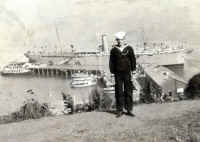 |
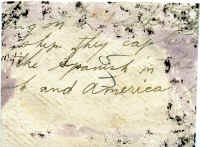 |
| "U.S. Naval Air - H.S. Wheeler Brest France" written on front. | Same photo obviously cut down from larger size. | On back of 2nd photo with much writing cut off, "... ing on bank ... ship they captured ... the Spanish in the ... Spanish (?) and American war (?)" (Could it be the USS Panther?) |
From his letters we
also learn that he is spending some of his time in the “transportation
dept.” and driving trucks.
The so-called “War to end
all wars” wound down with a ceasefire on
You
see I'm in the transportation dept. so are all the truck drivers.
And there will be lots of stuff to haul after peace is signed.
Yesterday I went on liberty. You
ought to have been here and seen the president when he landed.
There was ten super dreadnoughts & a bunch of destroyers that
convoyed him in. It was sure some
sight to see all those battle wagons come steaming in.
Today the French are having a holiday celebrating.
The town is all decorated with flags and large signs saying (Long Live
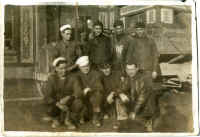 In
a “P.S.” to a
In
a “P.S.” to a
In mid January 1919 he
writes:
I
don't know if I will go back to the States for some time yet.
They are shipping most of the regular drivers to 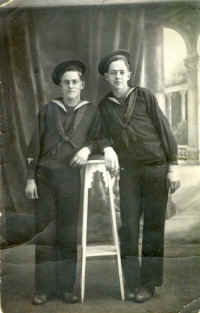
You take a look at the battle field where there were happy homes once and
all you can see is ruined buildings and big shell holes all over the country.
Everything is as still as night, not a sound.
The smell of the battle field will make you sick.
You see bodies of soldiers that were never buried and some that they do
bury have only a thin layer of dirt thrown over them.
You see lots of the Yankee boys who have fallen, probably places where
they could not be seen easily, and are still laying with their clothes nearly
rotted off of them. The Germans they
don't bury very good. They just
throw them in a shell hole, probably sprinkle some dirt on the top of them.
So you can see how awful a place it is.
As far as you can see is nothing but ruined country like this.
I hope there is no other war like this.
St Clare on left with "chum" W.D.
Menges
of Kansas City, KS, on right.
On
I
have got off of the trucks now and I'm driving a light "White"
passenger bus. I make trips all over
the country hauling officers &
I usually make trips like these all over the country at nights and there
is sure some sights to see, old castles, large arches that have been up for
centuries, for this part of the country is one of the oldest places in France.
I wish you were here to see some of the scenery for it is entirely
different from the scenery in the States. Everything
is built out of stone, streets, houses, walls, even their electric &
telephone poles are stone or concrete.
Changes are in the wind
when he writes the following on
We
are going to leave here in a few days. I
don't know where we're going but we have to move (tout de suit) out of the
station for the French aviation are taking it over.
St Clare’s living
descendants do not know what happened next.
Did the
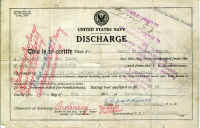 His Navy discharge certificate indicates that he was released from the
Navy directly from the ship of his return, the USS Graf Waldersee, on
His Navy discharge certificate indicates that he was released from the
Navy directly from the ship of his return, the USS Graf Waldersee, on
After
his discharge on the East Coast, he returned to
HIS WORLD WAR ONE PHOTO ALBUM MOSTLY FROM BREST FRANCE NAVAL AIR STATION
Photographs
and documents on this page have been found in family albums and belongings.
Only recently, an old photo album has come to the attention of St
Clare’s youngest children. This is
an album wherein someone, probably St Clare or his wife Doris, collected his
photographs from
|
Sample from Volume 1 |
Google Photos album
Volume
1
Google Photos album Volume
2
Google Photos album Volume
3 |
|
We
have been
graciously assisted by historian friends from the Brest, France area and have
beem
updating captions to the above volumes (Feb 2015). We thank members of 2
Brest area historical groups for their very helpful input. We especially
thank members of "Ile
Longue" (AMD) and "Mémoire
de Saint-Pierre" (MSP).
We
invite any additional comments, corrections or other input regarding these photos and their
identification. Please e-mail Keith
at:
.
For updated information on the Brest Air Station and Harry St.Clare Wheeler's photos, see Peg & Keith Wheeler's Travel Reports from their 2014 trip to Europe, especially Reports #8, #10, #11, & #13 from their days in the Brest area of western France.
19 old French picture postcards were later found among family articles. These were loose postcards depicting scenes (probably before WWI) in the French cities of Brest, Paris and Bordeaux. The scanned images of these postcards may be accessed by CLICKING HERE.
Attempts to obtain more of St. Clare's military records from the National Personnel Records Center in St. Louis, Missouri, so far have been unsuccessful.
More
on St Clare, his life and family can be found on the WheelerFolk.org genealogy
pages. See: http://www.wheelerfolk.org/keithgen/d2.htm
For more on the family plumbing shop business see: http://www.wheelerfolk.org/norweb/plumbingshophistory.htm
Material from this web site was published in a Colusi Co. Historical Society article entitled, "The World War I Experiences of Harry St. Clare Wheeler," Wagon Wheels, Fall 2008, Vol. 58, Nr. 2, pp. 5-9.
To WheelerFolk.org homepage
Family Photo Index Page
sorry - page counters all crashed when GoDaddy stopped supporting our outdated web editing software